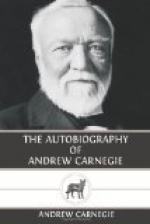The Pittsburgh of 1850 was very different from what it has since become. It had not yet recovered from the great fire which destroyed the entire business portion of the city on April 10, 1845. The houses were mainly of wood, a few only were of brick, and not one was fire-proof. The entire population in and around Pittsburgh was not over forty thousand. The business portion of the city did not extend as far as Fifth Avenue, which was then a very quiet street, remarkable only for having the theater upon it. Federal Street, Allegheny, consisted of straggling business houses with great open spaces between them, and I remember skating upon ponds in the very heart of the present Fifth Ward. The site of our Union Iron Mills was then, and many years later, a cabbage garden.
General Robinson, to whom I delivered many a telegraph message, was the first white child born west of the Ohio River. I saw the first telegraph line stretched from the east into the city; and, at a later date, I also saw the first locomotive, for the Ohio and Pennsylvania Railroad, brought by canal from Philadelphia and unloaded from a scow in Allegheny City. There was no direct railway communication to the East. Passengers took the canal to the foot of the Allegheny Mountains, over which they were transported to Hollidaysburg, a distance of thirty miles by rail; thence by canal again to Columbia, and then eighty-one miles by rail to Philadelphia—a journey which occupied three days.[12]
[Footnote 12: “Beyond Philadelphia was the Camden and Amboy Railway; beyond Pittsburgh, the Fort Wayne and Chicago, separate organizations with which we had nothing to do.” (Problems of To-day, by Andrew Carnegie, p. 187. New York, 1908.)]
The great event of the day in Pittsburgh at that time was the arrival and departure of the steam packet to and from Cincinnati, for daily communication had been established. The business of the city was largely that of forwarding merchandise East and West, for it was the great transfer station from river to canal. A rolling mill had begun to roll iron; but not a ton of pig metal was made, and not a ton of steel for many a year thereafter. The pig iron manufacture at first was a total failure because of the lack of proper fuel, although the most valuable deposit of coking coal in the world lay within a few miles, as much undreamt of for coke to smelt ironstone as the stores of natural gas which had for ages lain untouched under the city.
There were at that time not half a dozen “carriage” people in the town; and not for many years after was the attempt made to introduce livery, even for a coachman. As late as 1861, perhaps, the most notable financial event which had occurred in the annals of Pittsburgh was the retirement from business of Mr. Fahnestock with the enormous sum of $174,000, paid by his partners for his interest. How great a sum that seemed then and how trifling now!




